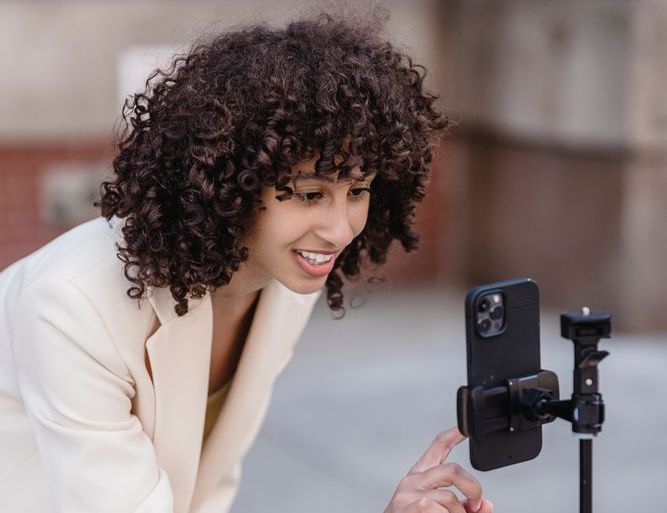Hybrid events, live streams, webinars; Organizing online events has become an integral part of the business event range. Event organizers are increasingly organizing online events. But when do you opt for an online event? What is the added value? And what should you pay attention to? Discover three popular variants.
Organizing online events type 1: Hybrid event
A hybrid event is a first form of organizing online events. It is a combination of a physical event and an online event. In a hybrid event, the online portion of the event must be more than just a live video stream, there must be interaction. This interaction must be there to continue to stimulate the external participants. When handled properly, a hybrid event can generate up to ten times more reach compared to a physical only event. It’s all about the experience you offer the participants online. A hybrid event can also consist of multiple physical locations. You use more or less the same approach for this.
A hybrid event is not a last-minute choice that you make because the number of participants is disappointing. From the early stages of the event, you already think about the information you want to share online and how you want to display it. There are various reasons for choosing a hybrid event: perhaps some of the participants are abroad, not everyone has time to travel to the event or you only want to physically invite the most important relations from the target group. In any case, make sure that the choice for a hybrid event is made early and think carefully about what you want to achieve (online).
What are the success factors when organizing a hybrid event?
- Experience! Use multiple cameras to create the most dynamic possible image of the event location for the online participants. When you are constantly looking at the same image, it quickly becomes boring.
- Attention! The online participants must be actively involved in the physical event. Give online participants the opportunity to ask questions, which are then answered directly by the speaker at the physical event. Have them actively participate in the program through a poll. Provide an extra incentive that is offered at the end of the event, such as receiving the presentation(s).
- Connect offline to online! Thanks to a handy chat, the offline and online participants can get in touch with each other.
- Promote not only the physical event but also the online broadcast, clearly indicating why the online broadcast is so interesting. Is there an important speaker or interesting guest coming?
- Fill in the breaks with, for example, an exclusive interview with one of the speakers.
- Clearly hear and see which questions come from the physical location and which from an online participant.
Organizing online events type 2: Livestream
With a live stream, the participants can watch online through live video and audio coverage. The difference between a hybrid event and a livestream is that with a livestream there is no direct interaction with the online audience, the participant only watches.
Live streams can be used as a form of marketing. You give online participants a look at your event in the hope that they will attend the next edition themselves. Live streams can also be used for informational purposes, for example a stream of an important presentation.
What are the success factors when organizing a live stream?
- The quality of the live stream has to be good, especially since there is no interaction and the viewer has to stay engaged in other ways. A sharp image, clear sound and minimal impact on the network connection are key.
- Take advantage of the on-demand capabilities of live streams, especially when using the recordings for marketing purposes. A good video report is ideal content for the promotion of the next edition.
- There are many different providers of live streams, they range from free applications to paid variants. Make sure you choose the right application for your event. For example, do you want extensive analysis options or is it important that the application is properly secured? Both hybrid events and live streams often involve other challenges than just the application itself. Test the supplier’s experience against the factors that can influence a smooth process.
Organizing online events type 3: Webinar
Unlike a hybrid event and a live stream, a webinar only has an online audience. A webinar is based on the one-to-many principle where a presentation is given to an online audience. Numerous interactive opportunities are available between the participants and the presenter(s).
A webinar can be recorded in a professional studio but also at your own location, making holding a webinar accessible to everyone. Webinars can be used for various purposes, for example for online training, lead generation and product presentations.
What are the success factors when organizing a webinar?
- Interaction, interaction, interaction! Keep participants engaged by using chat, poll and open audio lines.
- Exclusive content! Introduce your relations to a new product that is specifically applicable to them. This allows you to make product innovation launches more concise and more relevant to your target audience. In smaller groups there is also more room for questions and answers.
- Make sure you have the right technology tools. Provide a well-insulated room with an appropriate background, preferably not too busy, that only distracts. An external webcam and microphone ensure good image and sound quality. Nobody wants a faltering image or an unintelligible presenter. Measure the speed and stability of the internet connection in advance. You can do this with free online tools. For the main presenter in a webinar with 1 to 2 presenters, 1 Mbps is sufficient. A minimum download speed of 0.5 Mbps applies to the participant. Wired internet is recommended for a stable connection because WiFi can be lost. And test-test-test. A dress rehearsal also applies to the co-presenter(s).
- Registrations for a webinar start about four weeks in advance, so start promoting your webinar on time. Most registrations take place the week before a webinar, so promote your webinar through various channels during the last week.
One advantage keeps coming back; you increase the reach of your business events by offering participants the opportunity to experience the event when they cannot be physically present at the event. With this type of online event organizing, the participant also has a replay, or on-demand, which has the added advantage that the participants choose and relive the topics of interest to them!
But first…
Do you want to get the most out of your online event? In that case, first make an inventory of the needs and challenges. Map the expectations of your visitors, the co-presenters and the other stakeholders and increase the chance of making your online event a success. Have fun organizing all those online events!



